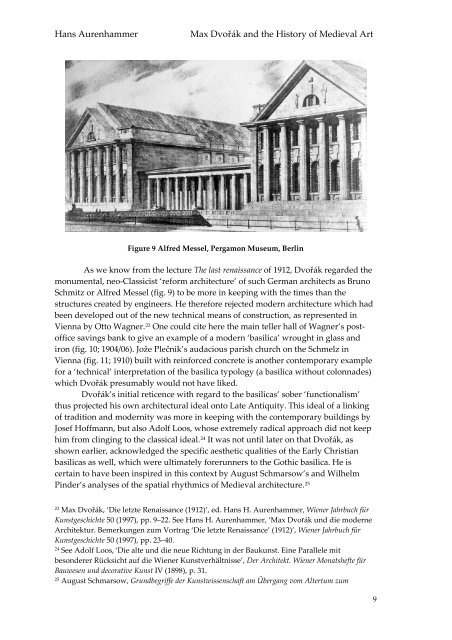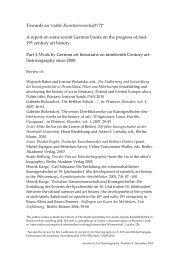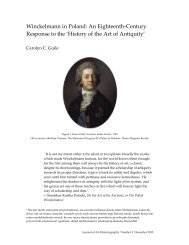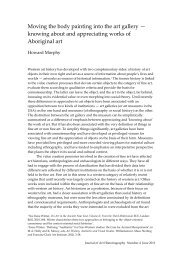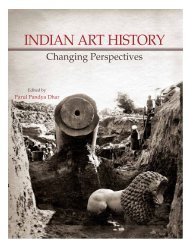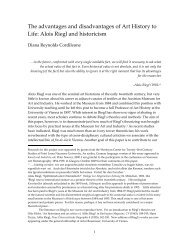Max Dvorák und die Revision der Mittelalter-Kunstgeschichte im ...
Max Dvorák und die Revision der Mittelalter-Kunstgeschichte im ...
Max Dvorák und die Revision der Mittelalter-Kunstgeschichte im ...
Create successful ePaper yourself
Turn your PDF publications into a flip-book with our unique Google optimized e-Paper software.
Hans Aurenhammer <strong>Max</strong> Dvořák and the History of Me<strong>die</strong>val Art<br />
Figure 9 Alfred Messel, Pergamon Museum, Berlin<br />
As we know from the lecture The last renaissance of 1912, Dvořák regarded the<br />
monumental, neo-Classicist ‘reform architecture’ of such German architects as Bruno<br />
Schmitz or Alfred Messel (fig. 9) to be more in keeping with the t<strong>im</strong>es than the<br />
structures created by engineers. He therefore rejected mo<strong>der</strong>n architecture which had<br />
been developed out of the new technical means of construction, as represented in<br />
Vienna by Otto Wagner. 23 One could cite here the main teller hall of Wagner’s postoffice<br />
savings bank to give an example of a mo<strong>der</strong>n ‘basilica’ wrought in glass and<br />
iron (fig. 10; 1904/06). Jože Plečnik’s audacious parish church on the Schmelz in<br />
Vienna (fig. 11; 1910) built with reinforced concrete is another contemporary example<br />
for a ‘technical’ interpretation of the basilica typology (a basilica without colonnades)<br />
which Dvořák presumably would not have liked.<br />
Dvořák’s initial reticence with regard to the basilicas’ sober ‘functionalism’<br />
thus projected his own architectural ideal onto Late Antiquity. This ideal of a linking<br />
of tradition and mo<strong>der</strong>nity was more in keeping with the contemporary buildings by<br />
Josef Hoffmann, but also Adolf Loos, whose extremely radical approach did not keep<br />
h<strong>im</strong> from clinging to the classical ideal. 24 It was not until later on that Dvořák, as<br />
shown earlier, acknowledged the specific aesthetic qualities of the Early Christian<br />
basilicas as well, which were ult<strong>im</strong>ately forerunners to the Gothic basilica. He is<br />
certain to have been inspired in this context by August Schmarsow’s and Wilhelm<br />
Pin<strong>der</strong>’s analyses of the spatial rhythmics of Me<strong>die</strong>val architecture. 25<br />
23 <strong>Max</strong> Dvořák, ‘Die letzte Renaissance (1912)’, ed. Hans H. Aurenhammer, Wiener Jahrbuch für<br />
<strong>Kunstgeschichte</strong> 50 (1997), pp. 9–22. See Hans H. Aurenhammer, ‘<strong>Max</strong> <strong>Dvorák</strong> <strong>und</strong> <strong>die</strong> mo<strong>der</strong>ne<br />
Architektur. Bemerkungen zum Vortrag ‘Die letzte Renaissance’ (1912)’, Wiener Jahrbuch für<br />
<strong>Kunstgeschichte</strong> 50 (1997), pp. 23–40.<br />
24 See Adolf Loos, ‘Die alte <strong>und</strong> <strong>die</strong> neue Richtung in <strong>der</strong> Baukunst. Eine Parallele mit<br />
beson<strong>der</strong>er Rücksicht auf <strong>die</strong> Wiener Kunstverhältnisse’, Der Architekt. Wiener Monatshefte für<br />
Bauwesen <strong>und</strong> decorative Kunst IV (1898), p. 31.<br />
25 August Schmarsow, Gr<strong>und</strong>begriffe <strong>der</strong> Kunstwissenschaft am Übergang vom Altertum zum<br />
9


